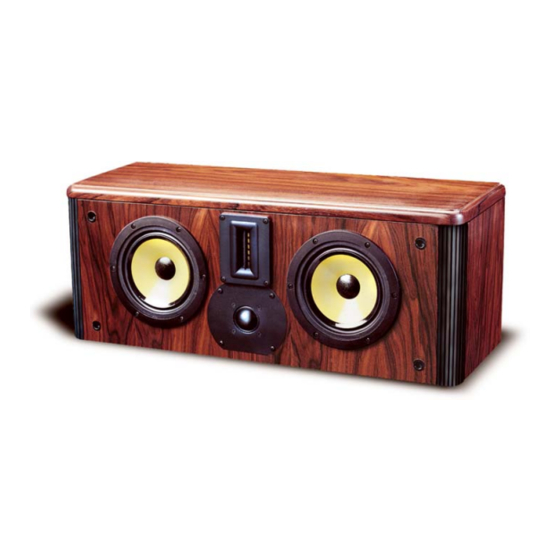
Summary of Contents for Legacy Silverscreen II
- Page 2 Registration 3. Owners Record 4. The Cabinetry / Our Commitment Setup 5. Unpacking Your Speakers 6. Speaker Placement / Installation 8. Hook up Cables 9. Amplification 12. Speaker Connections 13. Fine Tuning Technology 14. Designer’s Note 16. Specifications...
- Page 3 The model and serial numbers are located on the rear of the unit. Record these numbers in the spaces provided below. Refer to them when calling upon your dealer regarding this product. Model No. _______________________________ Serial No. _______________________________ Date of purchase: _________________________ Thank you for selecting a Legacy Loudspeaker System.
- Page 4 Handcrafted Beneath the surface of Silver Screen II’s elegant exterior lies rigid MDF construction. Interlocking joinery maximizes the strength of the cabinet parts. Polyester fiberfill is selected for internal damping. A sharp rap on the enclosure will leave you with little more than bruised knuckles. Each cabinet is impeccably finished on all exposed surfaces with select veneers.
- Page 5 V-board corner protectors. Molded foam end caps are used to protect the elegant cabinetry, and a plastic liner is provided as waterproofing. Please save this packing for future transportation. If cartons become damaged or misplaced, new ones can be purchased from Legacy Audio.
- Page 6 To allow more flexibility in seating arrangements, your Legacy loudspeaker is designed for broad lateral coverage. Optimal listener position is actually about 5 to 15 degrees off of the axis normal to the loudspeaker baffle (approximately 4-5’ off the floor). Your Legacy speaker is optimized for a flat response in the far field.
- Page 7 The ideal conductor would have negligible resistance, inductance and capacitance. The table below shows how a few actual speaker cables measure up. Cable Ωs/ft pF/ft µH/ft 12 ga. 0.0033 0.21 14 ga. 0.0048 0.13 16 ga. 0.0079 0.18 18 ga. 0.0128 0.21 Capacitance is considered insignificant in each cable because its effect is...
- Page 8 What about phase shift due to frequency dependent travel times down the speaker cable? Measurements show that 100 Hz waves will be delayed about 20 billionths of a second behind 10 kHz waves when traveling to the end of a 10 foot speaker cable. Since the cilia of the ear requires 25,000 times longer than this just to transmit phase information, phase shifting is obviously not the primary concern when considering speaker cables.
- Page 9 Ideally the loudspeaker would be among the first components selected when assembling a playback system. This would allow the user to choose an amplifier capable of delivering adequate amounts of current into the frequency dependent load presented by the loudspeaker. However, when upgrading a system, audiophiles may find themselves matching their new loudspeakers to their existing amplification.
- Page 10 How much power will your new speakers need? That ultimately depends on your listening environment and musical tastes. As little as five watts per channel should drive them to a level satisfactory for background music. A typical 45 watt per channel receiver may fill a room with the compressed mid-band energy of “heavy metal,”...
- Page 11 When an amplifier is unable to fulfill your loudspeakers demands, a damaging harmonic spike may be leaked to the high frequency drivers. Another important point regarding loudness is that the dB scale is a logarithmic one. This means that a 150 Watt amplifier will potentially sound only twice as loud as a 15 Watt amplifier.
- Page 12 At the rear of each of your loudspeakers you will find a terminal plate housing two rows of jumpered binding posts. The upper row is the input to the “satellite” portion of the speaker. The lower row is the input to the “subwoofer” portion of the speaker.
- Page 13 To facilitate proper set-up of your speakers in a variety of room situations, we have included several heavy duty toggle switches on the terminal plate, located on the back of the loudspeaker. All switches in the “up” position represent the “anechoic flat”...
- Page 14 How many times have you missed a critical line of film dialogue over muffled or tinny sounding TV speakers? Have you ever found yourself cranking up the volume to an aggravating level just to avoid missing the plot? High school geometry taught us that a location in free space can be specified by the coordinates of a single point and that two such points can describe a line.
- Page 15 Midrange information is delivered by a 1.25” soft textile dome positioned strategically below the ribbon tweeter. Vocals are silky smooth with incredible articulation free of any harshness. If you require some attenuation, simply throw switch 3 in the down position. All midbass is masterfully controlled by a pair of handmade 7”...
- Page 16 System Type: 4 drivers, 3 way. Tweeter: 4” Ribbon. Midrange: 1.25” soft textile dome. Midwoofer: (2) 7” Kevlar®. Low Frequency Alignment: B4 Reflex. Sensitivity: 98 dB @ 2.83 V/1m. Frequency response: 48 Hz - 30 kHz +/- 2 dB. Crossover frequency (Hz): 2.2k, 12k. Recommended Amplification: 10 - 300 watts/channel.
- Page 17 Notes:...
- Page 18 © 2003 Legacy Audio 150 Locust Street. Macungie, PA 18062 Phone: 610 965 0494 Fax: 610 965 4915...















Need help?
Do you have a question about the Silverscreen II and is the answer not in the manual?
Questions and answers